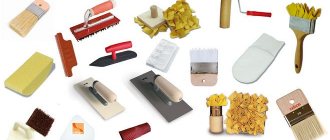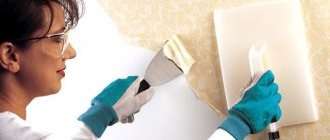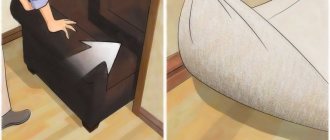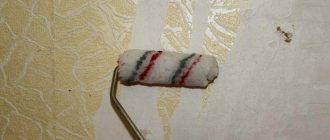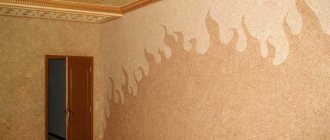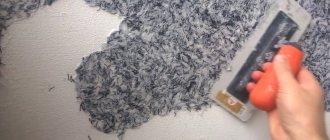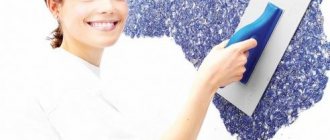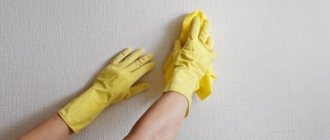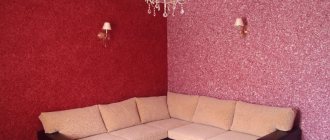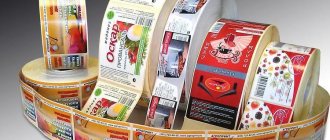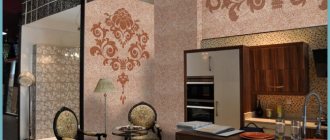What is liquid wallpaper?
Before we begin the process of removing liquid wallpaper, let’s find out what kind of material it is. It turns out that the composition of the wallpaper is a multi-component mixture, which can vary depending on the model.
But three components are necessarily present in them, and these are:
- natural base made of cellulose, silk or cotton;
- binding component (glue). This could be CMC, which is based on modified starch, or PVA glue, which is more effective. You can find out more about how long it takes PVA glue to dry after application from our article;
- water-based acrylic dye.
In order to give the effect of liquid wallpaper, various fillers are included in the mixture. It can be plastic or stone chips, mica, sparkles, threads, etc. We can say that the properties, type and cost of this finishing material will depend on what is included in the mixture.
To obtain the finishing material, the mixture is diluted in a certain proportion with water and the resulting paste is applied to the work surface. As soon as the mass hardens, it will be resistant to mechanical damage, shock, etc. To make the wallpaper even stronger, they are coated with paint (acrylic, water-based, latex, etc.) or varnish.
Tools
@220-volt.ru
It will not be possible to clean the surface quickly and efficiently if you don’t have a good and reliable tool at hand. To remove liquid plaster from walls manually you will need:
- wallpaper tiger;
- putty knife;
- a bucket for diluting the solution, a roller or sponge;
- empty bucket for the removed coating.
If the surface was removed using clean water, the liquid mass can be reused. There should be no plaster or debris left in the mixture. To store it, you need to dry it properly and leave it until the next repair, or put the raw mixture in a bag and seal it tightly. It can be stored for no more than 2 weeks. During this time, you can renovate another room.
Liquid wallpaper can also be removed using electrical equipment. Used: irons, steam generators, industrial hair dryers, grinders.
How to prepare a solution for removing liquid wallpaper?
It is necessary to immediately warn that removing the old coating is not entirely easy. Since it is evenly applied along the base of the surface, it has already hardened and acquired sufficient strength. The difficulty is that it is impossible to remove the striped trim, like simple wallpaper. It adheres tightly to the base and crumbles when removed. We recommend that you read the review: how long does it take for wallpaper to dry after hanging.
This recipe is suitable for removing decor that has not been coated with varnish (paint). The solution is prepared based on the thickness and density of the layer.
The use of such a solution allows you to quickly finish the job:
- the first method (the simplest) - the surface is moistened with warm water and, after it gets wet, removed with a spatula;
- the second method (considered more effective) is to wet the surface of the wallpaper with warm water to which household chemicals have been added. Such chemicals are sold in stores that sell finishing materials. It is specially designed for removing liquid wallpaper.
Handy tools for removing wallpaper:
- A piece of laundry soap is grated on a grater with large holes, placed in a container of water (4 liters) and boiled. The resulting solution is mixed well.
- Take 0.6 liters of fabric softener or any dishwashing detergent and dissolve it in 10 liters of warm water. You can use these two products at the same time by mixing them in arbitrary proportions.
- Vinegar (2 tablespoons) is mixed with hair conditioner (2 tablespoons) and added to warm water (5 liters). The solution is ready for use.
All of the recipes given are absolutely safe for health, so they can be used even if there are small children and animals at home.
Removing wallpaper from drywall
If the surface was not primed before applying liquid wallpaper to drywall, removing the layer will be problematic. Under the influence of water, not only the liquid wallpaper will become wet, but also the drywall itself. In this case, after removing the liquid wallpaper, you will also have to repair the wall. In this case, there is no point in cleaning the surface; you can repair it or decorate worn areas on the wall with liquid wallpaper of the same color or composition. You can choose a different shade and decorate the wall.
If a primer was applied before applying liquid wallpaper, the surface is removed manually, using a steam generator or hairdryer. A grinder or grinder is used carefully in both cases, being careful not to break the drywall.
Preparatory work
It is much more difficult to remove finishes with a protective layer applied. The varnish layer does not allow the solution described above to penetrate into the material and soften it properly. Therefore, it is necessary to use a power tool that will help remove it. For this process, choose an electric drill with a specially designed attachment or an ordinary grinder. The second option is much more effective and easier to use.
Before you begin work on removing coatings from walls and ceilings, you should carefully prepare the room. It is worth noting that removing wallpaper using electrical equipment is accompanied by a huge amount of dust and debris, for this reason the room must be properly prepared.
The preparatory stage includes:
- The room where renovation is planned must be cleared of furniture. Large furnishings that cannot be moved can be moved to the center of the room and wrapped in thick film or paper.
- Doors, windows and window sills must be protected with polyethylene and tape. It is advisable to dismantle the platbands so as not to damage them.
- To prevent very fine dust and debris from penetrating into small cracks and crevices, remove skirting boards and baguettes. Polyethylene or cardboard is used to protect the floor covering.
- We turn off the power supply. We remove the frames from the sockets and the keys from the switches. Then we close/seal them with masking tape.
- Chandeliers and lamps must be covered with film and secured well with double-sided tape. Avoid open areas.
Preparing the premises
Cover the furniture with polyethylene if it is not possible to remove it.
The very process of removing the final finishing of the walls is accompanied by the appearance of debris, wallpaper dust and various liquid contaminants. To make it easier to clean the room after the dismantling work is completed, you need to prepare the room for this:
- remove all furniture from the room. Wrap items that are difficult to carry with protective material.
- If possible, remove the trim from the doorway. Cover the door leaf with plastic film;
- wrap the film with film around the window frame and sill;
- remove decorative frames from switches and sockets;
- cover switches and sockets with masking tape;
- the floor and baseboards are covered with polyethylene;
- lamps (sconces, chandeliers, spotlights) are covered with film.
Such careful preparation of the room is necessary when the finishing is removed using a grinder.
Using a spatula to remove wallpaper
Using a regular metal spatula to remove liquid wallpaper is the most budget-friendly option, but the procedure itself takes a lot of time. Experts believe that a spatula can only be used if no varnish or paint has been applied to the coating.
What you will need to complete the job:
- metal spatula. It is good if the spatula has a curved handle, because... this will make work more efficient;
- deep container with warm water;
- brush with thick bristles (wide) or roller.
Work order:
- Notches are made throughout the entire coating using a knife, the corner of a spatula or a wallpaper tiger. The distance between the notches should be small. This will speed up the soaking of the wallpaper after wetting it with the solution.
- You need to dilute the purchased mixture in warm water to soften the coating, or you can use one of the recipes described above. It is important that the composition must be warm, this promotes faster dissolution of the adhesive mass.
- Using a brush (fur roller), the wallpaper is covered with a solution. If necessary, do this several times to make the surface loose.
- After some time, the wallpaper will become more flexible. You need to take a spatula and remove the decor.
REMEMBER! If it was not possible to remove some fragments of the soaked wallpaper, you can moisten them again and then remove them. It is possible to warm up “stubborn” areas with an ordinary hairdryer, which will help speed up the process. A household steam generator will significantly speed up the work.
All tools and auxiliary materials
Despite the fact that we are only trying to remove liquid wallpaper here, and not covering the surface with plasterboard, the list of necessary tools and some materials looks more than impressive:
- protective film;
- a bucket or any other container for water;
- grinder;
- hair dryer (industrial);
- steam generator;
- spatula (roller with needles);
- scraper;
- scotch;
- detergent.
How to remove liquid wallpaper from walls with a sander?
If a protective layer is applied to liquid wallpaper, it is much more difficult to remove it. The film formed by the varnish prevents liquid from penetrating into the coating and prevents it from softening. This coating can only be removed using a power tool. A drill equipped with a special attachment or a grinder, which is much more convenient to use, is suitable for this.
To quickly remove wallpaper, you need to take a straight sander. Any work with a grinding tool is accompanied by the accumulation of a large amount of dust. Removing wallpaper is no exception. In addition, you need to be able to use a grinding machine, the use of which requires great physical strength and endurance.
Before you start, you need to:
- wear safety glasses and protective clothing;
- put on a respiratory bandage that protects the respiratory system from dust.
During work, you must adhere to the following rules:
- Connect the power tool to the power supply via an extension cord.
- Make sure to press the machine firmly against the surface of the wallpaper. Remove the coating gradually, in small areas.
- Do the work carefully so as not to injure yourself.
- Every 30-40 minutes we take a short break for 10-15 minutes. This time is necessary to cool the instrument.
To remove wallpaper, you can use not only a grinding machine, but also a grinder if you fix a special grinding wheel on it.
IMPORTANT! Be sure to attach all attachments to the electrical appliance to protect the walls from damage during operation, and follow safety measures.
All the work of removing the old coating with a sander takes a lot of time. It will take 12-14 hours to free up 10 m2. There is no way to complete the process any faster.
The work is labor-intensive and complex, therefore, this method is sometimes abandoned. The decor is cleaned up a little, the pronounced (large) relief is removed. Next, the surface is treated with a primer and thoroughly puttied. In this way it is prepared for further finishing. We recommend that you familiarize yourself with the material: how long does the putty dry on the walls after application.
Is it possible to reuse liquid wallpaper?
If you carefully remove the coating using a spatula, after steaming or wetting the wall surface, the material can be used again. In order to prepare the mixture for application, you must perform the following steps:
- dry the pieces of coating removed from the wall;
- determine the required amount of water according to the instructions for this type of wallpaper;
- soak and thoroughly rub the mixture with your hands;
- leave the mixture for 12 hours;
- Add a little water to the settled mixture and mix again.
After this, you can begin applying the mixture to the wall.
Wallpaper that has been removed using a power tool cannot be reused.
Using an industrial hair dryer and steam generator
There is another equally effective way to remove old liquid wallpaper, if for some reason the first two methods are not suitable. You can remove wallpaper not only with a power tool and a metal spatula, but also with a hair dryer. But before you turn on the hair dryer, you will need to wet the walls with plain water or a solution.
A stream of hot air from a hair dryer penetrates deeply into the coating. Thanks to this, even very dense material can be removed efficiently and quickly. After treating the surface with a hairdryer, the coating can be easily removed using a scraper. We wrote about this method in the articles: how to remove a sticker from glass and how to remove glue from a sticker from plastic.
But this method has a number of disadvantages:
- work takes a lot of time;
- If wallpaper removed with a solution and a spatula can be reused, then after treatment with a hairdryer this will not be possible;
- A construction hair dryer is an electrically consuming tool.
Using a steam generator
A steam generator will help you quickly remove unvarnished liquid wallpaper, which can be used to soften it. From the hot steam, the material will become loose and can be easily removed with a spatula. But when working with this device you need to be as careful as possible so as not to get burned.
IMPORTANT! Since the walls will have to be wet, it would be better to turn off the power to the room for a while to avoid electric shock from a wet wall
Removal methods
Water
The most common method of removal is using water. It is necessary to use only warm liquid, which is absorbed into the finishing material as quickly as possible. In addition, water easily dissolves dried adhesive. As a result of getting wet, the wallpaper becomes pliable, making it easy to remove with a metal spatula.
Wallpaper glue
In some cases, wallpaper glue is used. This may be necessary when water flows onto the floor too quickly and practically does not linger on the surface of the old finishing material. Wallpaper glue in this case acts as a kind of thickener. It can be replaced with any other material that can perform a similar function. Thanks to the glue in the warm water, the liquid will acquire a thicker consistency, and after that it will be able to linger on the surface of the wall, and will also penetrate quite deeply into the material. However, we must remember that an excessive amount of thickener is also undesirable, because the product that acts as a binder simply will not release moisture.
Removing wallpaper applied in several layers
Liquid wallpaper is applied to the wall surface in a small layer. This is explained by the desire to save money. And if we also take into account the cost of this coverage, then this approach is considered completely justified. It must be taken into account that if the material is applied in several layers, in this case it must be soaked more than once. The next layer can be removed only after the previous one has been completely removed. The procedure must be repeated until the wall surface is completely cleaned.
Steam generator
Liquid wallpaper can be easily removed using a steam generator. Under the influence of hot steam, the coating quickly softens, making it easy to remove. The main thing to remember is that before work you need to prepare the room. If the dismantling technology involves the use of water, then the electricity in the apartment must be turned off.
Chemicals
To remove the old coating, special chemical compounds are used, which are added to water, and after the coating has softened, it is carefully removed with a spatula. The composition should remain on the surface for two minutes, after which you can begin the mechanical stage of removing the coating. This time is enough for the product to begin to affect the components of the material, destroying their structure. It will be easier to remove the wallpaper if you add a little wallpaper glue to the chemical solution. The resulting composition should dry on the wall, and then the coating can be removed - it will itself come off the walls in large pieces.
Removal from drywall
Often the material has to be removed from the drywall. The difficulty of this process is that the surface of the plasterboard walls remains unharmed. However, wallpaper glue copes well with this task.
Bulgarian
You can also use a grinder with a special grinding disc. In this case, work will happen much faster, but there will be more dust.
Construction hair dryer
The surface of the finishing layer can also be heated with a hair dryer. When the layer becomes soft, it will be easy to remove it with a metal spatula. However, this process is labor-intensive and requires a large amount of electricity.
Sander
You can use a sanding machine to remove wallpaper. It must be pressed quite firmly to the surface, which will require considerable physical effort, but the speed of work will be much higher. It should be borne in mind that this method generates a lot of dust, so it is recommended to use a respirator and safety glasses.
Removal from various surfaces
The basis for applying the material varies. For this reason, certain rules are set for performing work. Let's look into all the details.
Plasterboard surfaces (GCR)
GKL is a building material made of two layers of special thick paper (cardboard) between which there is a gypsum filler. Its strength is low, so using any power tools is strictly contraindicated. Any mistake can irreparably damage the gypsum board. Only manual removal is allowed, which also has a number of restrictions. One of them is a ban on the use of water. He is able to absorb it like a sponge and quickly becomes unusable.
For removal, it is allowed to use only the CMC paste composition or its modified versions. As a rule, it is diluted with more water (to a liquid state) than indicated in the instructions for use on the package. Treat the decorating coating to soak and after 20-30 minutes scrape it off with a spatula.
Putty or plaster
In general, there are no restrictions for such foundations. However, if you plan a mechanical cleaning process, you will need to set up the tool correctly. It is equipped with special nozzles that regulate the depth of removal of the formed layer. Since it is possible to remove a layer of plaster, putty or concrete along with the decor.
A hairdryer can also help
Of course, not the Rowenta that hangs on a hook in the bathroom, but a solid industrial one. It is used when the coating has already been doused with a solution and a little time has passed since this action. The old material heats up from the incoming hot air and quite quickly lags behind the wall. All that remains for you is to carefully and quickly remove the debris with a spatula. There were some downsides:
- It takes a very long time to work with a hairdryer;
- paint may fall off along with the wallpaper.
How to remove old coating?
Spatula and kitchen knife
You cannot remove old coatings without a spatula if they were glued 5-6 years ago:
- Find the area that is swollen from age, pry it with the edge of the tool, and pull gently.
- You cannot use force - the paper becomes very shabby. In an old home, the plaster on the walls may begin to crumble and fall off, leaving dents and holes.
- Use a spatula with a wide blade to pry up pieces that have become embedded in the plaster; if that doesn’t work, use a grinder.
Non-woven and vinyl wallpapers are easier to remove:
- Cut them down the middle.
- Then, using the tool to pry the edges, pull with your hands first the lower and then the upper half.
- Clean off any remaining residue with a stiff brush.
Water treatments
- Moisten fresh wallpaper (no more than 5 years old) generously with warm or hot water - the liquid will dissolve the glue and soften the paper, without damaging the plaster.
- Walls covered with water-repellent wallpaper need to be treated with a spiked roller - you can buy it at a hardware store. Even a sharp knife will do - the blade makes several cuts around the perimeter: the more cuts there are, the easier it is for water to seep inside.
Where ordinary water fails, folk recipes will help:
- Finely chop a bar of laundry soap, fill it with 3-4 liters of water, bring to a boil, stirring constantly. Soak a foam sponge in the solution and saturate the wall covering. After 20 minutes, start filming.
- You can use table vinegar - 400 ml per bucket of hot water, crumble a little laundry soap. You need to apply the mixture in parts: if you treat all the walls at once, some of the wallpaper will dry out and you will have to repeat the impregnation.
- Fabric softener (200-300 ml), mixed in a bucket of water, softens fabrics well with water-repellent properties. The mixture can be applied with a foam sponge or soft cloth, or using a spray bottle. The wetted wallpaper is lifted with a spatula and cleaned with sandpaper or a metal brush. The remains of the mixture are washed off the walls with warm water.
Steam cleaning
To steam, you need a regular iron, a thin wide towel (or sheet), a bucket of water and another pair of hands.
- Soak the cloth in water, squeeze out excess water, and apply it to the wall.
- Heat the iron and, after ironing the towel several times, remove it. Quickly scrape off any remaining wallpaper with a spatula. Paper wallpapers are relatively easy to remove, but when working on non-woven and vinyl wallpapers, you first need to remove the water-repellent film (read about the features of vinyl wallpapers and pasting here).
In addition to the iron, you can use a steam cleaner or steam generator: you don’t need to buy a special construction device, a household one is enough. They iron the wall through a dry sheet (it is necessary to use fabric so that dirt and dust do not get inside and cause damage).
Special compounds for quick cleaning
If you don’t have time to tear off, steam, pick out, but have extra money, buy a special tool for instantly removing wallpaper from the building materials market. It can be in powder or have a jelly-like consistency. Popular brands - Quelyd Dissoucol, Atlas Alpan.
- The powder is diluted with water, a roller is moistened in the prepared mixture, then the wall is treated.
- After 2-3 hours, the glue will dissolve and the paper layer will soften.
The wallpaper will begin to come off the wall on its own. They will be easy to remove even by hand.
Advice
Attention! Manufacturers assure that their solvents are non-toxic and do not harm human health.
It is necessary to follow standard safety rules when working with chemicals:
- use rubber gloves;
- protect your mouth and eyes from contact with the finished composition;
- do not eat or smoke while working.
Pets and children are also not recommended to be present.
Unusual options
- Many people do not completely remove vinyl and non-woven wallpaper - only the water-repellent layer. Of course, provided that the walls are smooth and without holes. New coatings can be safely glued over old ones.
- Glass wallpaper must be removed only with special removers. The walls are treated with them, allowed to swell (this will take several hours), and then cleaned off with a sharp blade or construction spatula. After treatment, the base of the wall must be dried, puttied, and primed.
- With liquid wallpaper, everything is simple - spray it with boiling water, wait 2-3 hours. Having absorbed moisture, the material will swell, partially fall off on its own, and partially be removed with a spatula.
hereherethis material
Useful tips
For high-quality repairs with your own hands, you should know a few secrets so as not to redo and protect the main surface and your own property.
- The ceiling is processed first. If the walls and floor will not be repaired, it is best to close them.
- All work should be done at room temperature.
- Rough liquid wallpaper can not be removed, but a new layer of decorated plaster or wallpaper can be applied to it.
- Despite the laboriousness of the process, it is best to remove the old layer, because mold or mildew may form behind it.
Work with dismantling the old coating will go smoothly if you don’t rush and do everything carefully and efficiently. If the composition does not come off after the first soaking, it should be wetted again. You definitely need to wait until the liquid wallpaper absorbs moisture.
Preparing to start work
To ensure that the procedure requires a minimum of effort and time, it is useful to acquire a set of useful tools. For the most basic case you will need:
- set of spatulas;
- household sprayer for liquids;
- paint brush (it’s better to stock up on different sizes);
- bucket for water.
Before removing liquid wallpaper, you need to soak it.
It is also necessary to prepare the room for the main stage of work. To do this, move all the furniture away from the walls and cover it with oilcloth. So that later the electrical accessories do not have to be cleaned of a layer of dirt and dust, it is better to seal them with tape. This will also reduce the risk of moisture getting inside.
